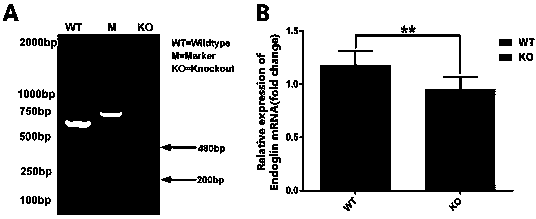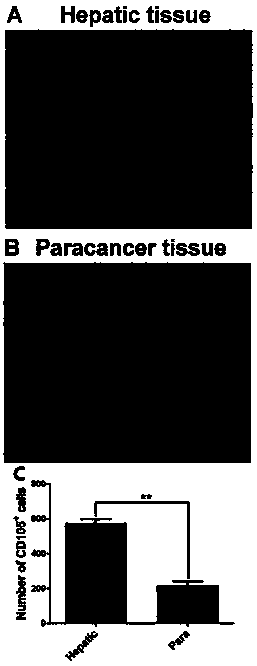Method for knocking out Endoglin gene by using CRISPR/Cas9 technology
A gene and technology technology, applied in the field of knocking out the Endoglin gene by using CRISPR/Cas9 technology, can solve the problem of weak tumor proliferation ability
- Summary
- Abstract
- Description
- Claims
- Application Information
AI Technical Summary
Problems solved by technology
Method used
Image
Examples
Embodiment 1
[0033] 1.1 Materials and methods
[0034] 1.1.1 Experimental materials
[0035] Liver cancer tissues and paracancerous tissues were collected from the Department of Hepatobiliary Surgery, Cancer Hospital Affiliated to Guangxi Medical University, and the expression of Endoglin was detected in tumor tissues and paracancerous tissues of patients with hepatocellular carcinoma by immunohistochemistry; human highly metastatic liver cancer cell line HCCLM3 was purchased from Shanghai Fuxiang Biological Co., Ltd.; female BalB / C nude mice used in the experiment, born (4-6) weeks old, weighing (18-20) grams, were purchased from the Medical Experimental Animal Center of Guangxi Medical University and raised in SPF grade Mouse housing. All animal experiment protocols comply with the animal protection and use management regulations of Guangxi Medical University, and have been certified by the Ethics Committee of Guangxi Medical University; the CRISPR / Cas9 system plasmid vector Px458 was p...
Embodiment 2
[0045] 2 results
[0046] 2.1 High expression of CD105 in liver cancer tissues of clinical patients
[0047] The specimens collected from patients with hepatocellular carcinoma were detected and analyzed by immunohistochemical methods. For tumor tissue specimens and paracancerous tissue specimens, see figure 1 A / B, visible CD105 + The number of cells in tumor tissue was significantly more than that in paracancerous tissue, and in figure 1 The statistical analysis of C showed that in tumor tissue CD105 + The number of cells is significantly more than that of the paracancerous tissue, ** P <0.01.
[0048] 2.2 The results of the sequencing peak map show that the sgRNA has been successfully inserted into the Px458 vector
[0049] figure 2 -A / B. The designed sgRNA sequence "GGACCGCGGCACGCTCCCTC" has been successfully inserted into the Px458 vector, and the target sequence has been marked in black font in the sequencing results of the Px458-gRNA 1 / 2 monoclonal plasmid.
[00...
PUM
 Login to View More
Login to View More Abstract
Description
Claims
Application Information
 Login to View More
Login to View More - R&D
- Intellectual Property
- Life Sciences
- Materials
- Tech Scout
- Unparalleled Data Quality
- Higher Quality Content
- 60% Fewer Hallucinations
Browse by: Latest US Patents, China's latest patents, Technical Efficacy Thesaurus, Application Domain, Technology Topic, Popular Technical Reports.
© 2025 PatSnap. All rights reserved.Legal|Privacy policy|Modern Slavery Act Transparency Statement|Sitemap|About US| Contact US: help@patsnap.com



